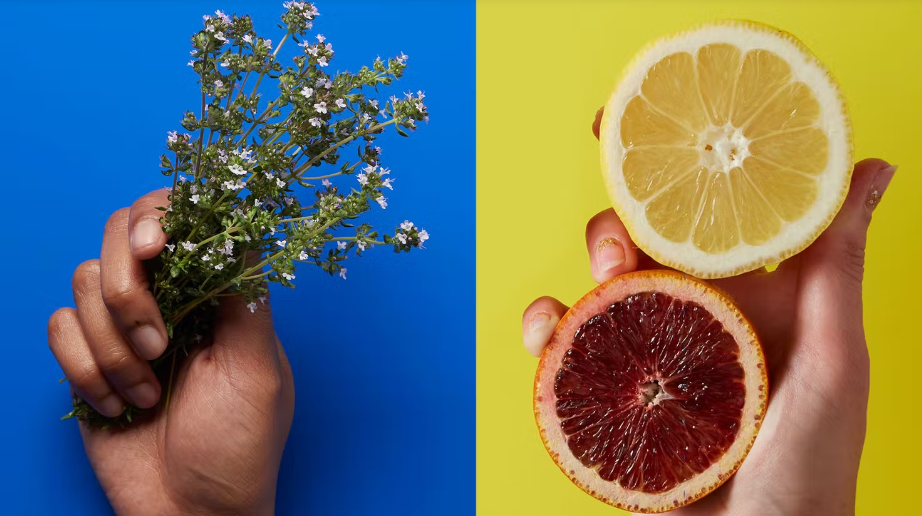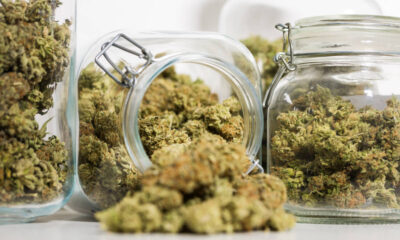Blogs
What are cannabis terpenes and what do they do?

The unique musky, skunky, and pungent aroma of cannabis is unmistakable: Most people can smell it before they even see it. Terpenes, the aromatic compounds that determine the scent of many flowers and herbs, bestow cannabis with its distinctive odor and contribute to its flavor.
Cannabis contains more than 150 types of terpenes. Although most terpenes are present in only trace amounts, the more prominent ones team together to give diverse cannabis strains their signature scent profiles. The combination of terpenes in Sour Diesel tell you of its pungent, gassy character, while Cherry Pie evokes the pleasant scent of sweet and sour cherry pie fresh out of the oven.
Beyond providing cannabis with its unique bouquet of scents, terpenes also hold diverse functions in the plant and can produce a range of therapeutic and mood-altering effects in cannabis consumers.
Where do terpenes come from?

Terpenes are naturally-occurring compounds found in the trichomes of female cannabis plants. Trichomes are sticky, translucent glands that cover the surface of buds, and in much smaller amounts, on leaves and stems. Critically, trichomes contain resin glands that produce terpenes.
Terpenes play an integral role in a cannabis plant’s growth and survival. Besides producing distinctive aromas, these organic compounds also enrich color and pigmentation in leaves and buds, and contribute to the flavor of cannabis. In short, terpenes help to enhance the plant’s attractiveness to some creatures, while deterring others that can do harm.
Certain terpenes like geraniol, for example, repel insects or herbivores that might be tempted to snack on cannabis. Other terpenes, like terpinolene and linalool, attract insects and other small creatures that can help spread pollen. These aromatic compounds support the plant’s immune system by conveying information about the surrounding environment, protecting plants from stressors and pathogens and helping to trigger immune responses.
A sweep of variables can affect the amount of terpenes a cannabis plant produces. Factors such as whether the plant is grown outdoors or indoors, exposure to light, temperature, certain growing mediums, nutrient levels, and when harvesting is carried out can all influence terpene levels.
Many terpenes are volatile compounds, meaning they are easily lost during standard cannabis extraction processes. However, growing awareness of the therapeutic value of terpenes is leading to more sensitive extraction methods, such as live resin.
Live resin is made from fresh frozen cannabis plants and maintains freezing temperatures throughout the extraction process to protect terpenes and other volatile compounds in the plant, leading to a more aromatically complex and flavorful cannabis experience.
How do terpenes affect the body?

Awareness of the aromatic properties of terpenes is not new. Humans have long harnessed the vibrant scents associated with terpenes to formulate essential oils for practices such as aromatherapy.
For example, anyone who’s dabbed lavender oil—which contains linalool—behind their ears knows that it can potentially help you relax you. Similarly, terpenes in certain cannabis strains can add to its effects.
However, the effects of terpenes appear to extend beyond feel-good benefits and stress relief. Terpenes have also been identified as a new frontier in cannabis medicine. Until recently, the spotlight has been focused almost exclusively on the therapeutic qualities of cannabinoids, such as THC and CBD, but as our understanding of terpenes grows more sophisticated, it’s becoming apparent that these aromatic compounds are medicinal powerhouses too.
All terpenes boast unique combinations of therapeutic properties. Unsurprisingly, some of the effects terpenes have on humans are evocative of their function in cannabis and other plants—like helping to fight off unwelcome microbes and pathogens.
The medicinal benefits of terpenes

Preclinical studies on animals and in vitro studies—in test tubes—have identified a range of therapeutic benefits associated with terpenes. It should be noted, however, that terpene research is in its infancy and has not been widely performed on humans. More research needs to be done to solidify our understanding of these compounds.
Antiviral
Researchers are always on the hunt for new antiviral compounds. Many terpenes could show strong abilities to help kill viruses, including alpha- and beta-pinene, caryophyllene, camphor, and carvone.
Anticancer
Rising rates in many forms of cancer are driving the quest to find compounds that can help suppress it. Some terpenes, including those found in cannabis, can exhibit anticancer activity, helping to inhibit the activity or growth of cancer cells.
Limonene could represent a particularly notable anticancer and antitumor agent, along with other terpenes such as pinene, camphor, terpinene, and beta-myrcene. One potential unique benefit of terpenes is that they may be unlikely to affect healthy cells or cause side effects—something important for cancer treatments.
Antidepressant
Twenty-five percent of antidepressant drugs are formulated using herbal extracts that contain terpenes. Linalool and beta-pinene are common among many plant extracts used in antidepressant medication.
Antimicrobial
A vast array of terpenes may display antimicrobial activity, or the ability to halt a harmful microorganism in its tracks. Terpenes that may help in killing or stopping the progression of microorganisms include alpha-bisabolol, geraniol, menthol, eucalyptol, and terpinolene.
Pain relief
Researchers have found that some cannabis terpenes may mimic cannabinoids by creating a pain-relieving effect. In one 2021 study that combined terpenes with cannabinoids, pain-relieving effects were amplified without an increase in negative side effects. This interaction could indicate the entourage effect (more below).
Terpenes that may promote pain-relieving activity include humulene, geraniol, linalool, and β-pinene. Fascinatingly, the study above also found that these terpenes activate the body’s CB1 receptors, which form part of the endocannabinoid system and influence pain perception.
How can terpenes contribute to the effects of cannabis?

Emerging evidence suggests that all plant compounds in cannabis work together synergistically—this is known as the entourage effect and can be thought of as: The whole of all compounds present in cannabis are more together than the sum of its parts. In other words, a special whole-plant synergy occurs when cannabinoids and terpenes are consumed together, as opposed to by themselves.
For example, terpenes appear to play a part in influencing the effects of THC and CBD in the body. In a 2018 review of people with epilepsy, those who took full-spectrum CBD extract—including cannabinoids and terpenes—experienced improved symptoms and fewer side effects than those who took CBD isolate, only containing cannabinoids. Full-spectrum cannabis extract is whole-plant medicine, containing cannabinoids, terpenes, and other compounds that are present in the plant.
The researchers also found that full-spectrum CBD extract was four times more potent than the CBD isolate, meaning patients could take a significantly lower dose, and attributed this to the therapeutic synergy of cannabinoids and other compounds, such as terpenes.
More recent research has found that terpenes boost cannabinoid activity, but high concentrations of terpenes were needed to see this enhancement.
It’s vital to acknowledge that much is still unknown about terpenes and their interactions with other terpenes, cannabinoids, and flavonoids present in cannabis. In addition, the majority of the research we do have is based on animal or test-tube models.
Nonetheless, growing clinical interest in these aromatic compounds is yielding some fascinating findings. It’s likely that the coming years will see a more sophisticated understanding of terpenes develop, and how they behave both individually and synergistically.
The top three terpenes found in cannabis

As mentioned earlier, there’s a staggering range of terpenes present in cannabis—more than 150 different types, to be exact. While many of these occur in concentrations too low to detect, some have a more robust presence.
Here’s the lowdown on three terpenes that are the most predominant in cannabis.
Myrcene
Most cannabis cultivars are dominant in either myrcene or caryophyllene. Myrcene, a terpene that’s also predominant in hops and lemongrass, has been described as delivering scent notes that are herbaceous, spicy, earthy, and musky. Myrcene gives cannabis a mildly sweet flavor profile—it’s also found in mangoes.
In addition to contributing to the signature scent of cannabis, myrcene can also deliver anti-inflammatory effects. A 2015 study in cultured cells indicates that myrcene may effectively reduce inflammation associated with osteoarthritis.
The terpene also appeared to help prevent the breakdown of cartilage cells, slow down the progression of osteoarthritis, and decrease the production of certain inflammatory cells produced by the body. Myrcene could potentially be harnessed to help alleviate anti-inflammatory diseases and their symptoms in the future.
Caryophyllene
Caryophyllene, also known as beta-caryophyllene or β-caryophyllene, lends a spicy, peppery bite to some cannabis strains. Caryophyllene is also found in other plants such as cloves, rosemary, oregano, and black pepper. If you catch any of these scents when you smell a certain cannabis cultivar, it’s likely because caryophyllene is present.
Caryophyllene is the only known terpene found in cannabis that can bind to the CB2 receptor in the endocannabinoid system, which is found in the body’s immune system. Thanks to this unique action, caryophyllene is sometimes also classed as an atypical cannabinoid.
Research into the therapeutic actions of caryophyllene shows that it has potential in easing symptoms in diverse conditions such as colitis, diabetes, cerebral ischemia, anxiety and depression, liver fibrosis, and Alzheimer-like diseases.
Future research suggests that caryophyllene’s activity at the CB2 receptor could be harnessed to help treat conditions that are accompanied by inflammatory symptoms.
Limonene
Clean, fresh, uplifting citrus-y scents—limonene’s name is a giveaway for the aromas associated with this terpene. Limonene is found in the rinds of citrus fruits and ginger, and the terpene is also predominant in many cannabis cultivars that have a fruity, fresh bouquet, like Papaya Punch or Black Cherry Soda.
Limonene appears to alter the way certain immune cells in the body behave, which may protect the body from a range of disorders. In one study, limonene helped to increase the production of antibody-producing cells in the spleen and bone marrow, which are used by the immune system to identify and neutralize pathogenic bacteria and viruses.
Researchers have also recently floated the idea that the unique therapeutic profile of limonene could be useful in treatments for Covid-19.
Source: https://www.leafly.com/news/cannabis-101/terpenes-the-flavors-of-cannabis-aromatherapy
Blogs
Border sales a boost for most marijuana retailers across US

Marijuana sales along state lines are key revenue generators for retail operators in the United States, and new insights suggest a similar business bump along international borders, particularly Mexico.
Data compiled by New York-based wholesale technology platform LeafLink – as well as information gathered from state agencies, quarterly reports and interviews with several cannabis companies – bear that out.
LeafLink analyzed hundreds of ZIP codes at the request of MJBizDaily and found strong links that when new recreational markets open, retailers near borders stock up on inventory significantly more than operators located elsewhere in a state.
Data from the past three years revealed wholesale marijuana products purchased by border stores jumped 140% after the launch of adult-use sales, while retailers located in more interior areas increased purchases by about 80%.
“The growth when a state launches adult-use sales at a border store in terms of purchasing activity is around double the growth of the remainder of the state,” LeafLink Strategy Analyst Ben Burstein told MJBizDaily.
Of course, numerous factors are at play – perhaps none more impactful than the marijuana policies of neighboring states.
That’s why Illinois retailers near Wisconsin, where marijuana possession is illegal, are still attracting Wisconsinites nearly four years after the launch of recreational sales.
There also are retail sales-tax implications, a big reason why St. Louis-areas operators are seeing an influx of shoppers from southern Illinois, where cannabis taxes are at least three times higher than in Missouri.
Meanwhile, border retail in New Mexico is boosting depressed economies along hundreds of miles of its shared borders, drawing stampedes of consumers from neighboring Texas and, more recently, cross-border buyers from Mexico.
Retail shakeup in the heartland
The February launch of adult-use sales in Missouri has caused ripple effects throughout the Midwest.
Missouri holds the rare distinction of bordering eight states, with only Illinois offering recreational marijuana sales.
Missouri’s 6% retail tax on recreational marijuana purchases is also among the lowest in the nation, drawing Illinois consumers across the Mississippi River in droves to buy much cheaper weed.
All in, cannabis sales taxes in neighboring Illinois eclipse 30%, second only to Washington state. And in Chicago, sales taxes can easily top 40%.
Demand is booming in western Missouri, too.
In April, Missouri retailers near the border of Kansas, where marijuana possession is also illegal, told MJBizDaily they were seeing foot traffic increase ninefold after expanding into recreational sales.
The rush of new customers, coupled with cultivation-capacity lags, has led to big spikes in wholesale flower prices and inventory shortages throughout the supply chain.
Retailers, for their part, are trying to keep pace.
To meet consumer demand, wholesale purchases per store in the Kansas City, Missouri, market increased from $97,000 in the quarter before the launch of recreational sales to $491,000 in the quarter after, a whopping 406% jump, according to LeafLink data.
In the St. Louis market, which borders southwestern Illinois, wholesale purchases per store increased nearly 57%, to $610,000, after adult-use sales began.
“The demand’s been bigger than anyone expected,” Burstein said.
A zero-sum game
In marijuana retail, particularly near state borders, it’s a zero-sum game.
The sales boom in the St. Louis market, which has more than 70 stores, has deflated business on the Illinois side of the border, where retailers have lost millions of dollars in sales since Missouri’s adult-use launch, according to quarterly reports and earnings calls.
Top executives at New York-based multistate operator Ascend Wellness Holdings, which has two shops near the Missouri border, cited revenue declines at its southern Illinois stores in recent earnings, saying it has led to suppressed margins that are expected to linger for much of the year.
Florida-based MSO Jushi Holdings, which also operates two Illinois stores near the Missouri border, reported an 8.8% year-over-year revenue decline to $66.4 million in its second quarter, partially attributing the slide to adult-use sales in Missouri.
In an Aug. 11 second-quarter earnings call, Jushi CEO James Cacioppo said total Illinois sales declined 20% from the first quarter and 40% year-over-year.
“I think we under-anticipated the pricing power initially out of the gate that retailers were going to have in Missouri,” Jushi Chief Strategy Director Trent Woloveck told MJBizDaily in an interview.
“The impact was a little bit greater than then we had thought due to that pricing for flower, vapes and infused products.”
In response, Jushi has implemented several initiatives, including adding new promotions and diversifying product SKUs (stock-keeping units) to ease the impact of declines sales in Illinois.
Northern exposure
Market dynamics in northern Illinois, particularly along the Wisconsin border, are a different story.
Wisconsin is among 10 states without a medical or recreational marijuana program.
Illinois counties bordering Wisconsin – including Lake, McHenry, Jo Daviess and Winnebago – accounted for 15.4%, or $239.7 million, of the nearly $1.6 billion in cannabis sales last year in the state, according to a fiscal analysis requested by pro marijuana-legalization lawmakers in Wisconsin.
The Wisconsin Legislative Fiscal Bureau report, which was released in March, cited annual statistics from the Illinois Department of Financial and Professional Regulation.
Moreover, the report estimated about 7.8% of marijuana sales in Illinois in 2022, roughly $36.1 million, were generated by out-of-state residents traveling from Wisconsin.
Under Illinois law, out-of-state residents can only purchase recreational cannabis.
Two of Chicago-based multistate operator Cresco Labs’ 10 stores in Illinois are located near the Wisconsin border: a Sunnyside outlet in South Beloit at the border and one in Rockford, about a 30-minute drive away.
The South Beloit store often draws up to 1,000 daily visitors, according to Cresco’s national retail president, Cory Rothschild – traffic on par with the nation’s busiest marijuana retailers in highly populated areas.
It’s all the more impressive, considering that South Beloit has a population of roughly 8,000 and is more than 40 miles from Madison, the nearest city and Wisconsin’s state capital.
“It’s an extremely high-volume retail location,” Rothschild told MJBizDaily.
“South Beloit and Rockford as well are probably (among the) top dispensaries in the country.”
Maryland
Maryland is the newest recreational cannabis market, with nearly 100 medical marijuana dispensaries having converted to adult-use retail in late June.
While LeafLink wholesale data suggests about a 10% increase in wholesale product purchases statewide after the launch of adult-use sales, some retailers along Maryland’s south and eastern borders are doubling orders to meet demand.
In Elkton, near the Delaware border, stores are ordering about $41,000 in wholesale products per month, up 115% since the launch of recreational sales on July 1.
In the Rockville/Germantown area – outside of Washington DC and near the Virginia and West Virginia borders – monthly wholesale purchases have increased about 42%, to $54,000 per store, since recreational sales began.
Though MMJ dispensaries opened in West Virginia in 2021, the state still has some of the harshest marijuana laws in the country, according to the Marijuana Policy Project.
Meanwhile, Virginia’s adult-use rollout has been put on ice by Republican Gov. Glenn Youngkin.
MSO MariMed’s wholesale business serving retailers in Maryland has benefited from increased demand from neighboring states, according to Jeff Jones, director of operations.
“We have retail customers that are very close to Virginia, Pennsylvania and West Virginia, and I’m sure that’s driving a significant amount of their business,” he said.
The Massachusetts-based company supplies every retailer in the state with its product brands.
MariMed is planning to double its cultivation and canopy space in Maryland, with product from that expansion expected to hit the wholesale and retail markets in the first quarter of 2024, Jones said.
Its retail operation in Annapolis – the state capital is about a 45-minute drive from Pennsylvania or West Virginia – hasn’t experienced the same type of uptick from border business but is still performing well, according to Jones.
A tale of two borders
The small town of Sunland Park, New Mexico, has racked up outsized sales since the state launched recreational retail in April 2022.
The sparsely populated bedroom community is situated across the border from El Paso, Texas, and Jaurez, Mexico, which have a combined population of more than 2.2 million.
That purchasing power has helped Sunland Park’s 88063 ZIP code top the state for per-capita adult-use spending, a sales metric that divides dollars spent for cannabis by population.
Per-person recreational marijuana spending in Sunland Park was $1,044, according to an MJBizDaily analysis of data from the New Mexico Regulation and Licensing Department.
Its 88063 ZIP code also houses two of New Mexico’s leading cannabis stores.
Ultra Health and Everest Cannabis Co. generated nearly $6.1 million in combined sales from August 2022 to February 2023, according to MJBizDaily research.
Because business has been so strong at that Sunland Park store, Ultra Health last summer opened an adjacent location that handles only online orders for pickups.
The majority of its 42 stores were strategically aligned to capture business along New Mexico’s more than 600-mile border with Texas, the second-most-populated state.
“I would say half our business is Texas-related,” Ultra Health CEO Duke Rodriguez told MJBizDaily.
As part of that strategy, the company is planning to open an outlet in Lordsburg with hopes of drawing customers from Mexico, Texas and Arizona.
Mexico border towns share more than commerce, including family, culture and language.
Some residents own commercial properties and homes on either side of the border.
And residents tend to travel freely between Juarez, El Paso and Sunland Park to shop, dine and visit friends and family, according to Rodriguez.
Many also buy regulated marijuana, which might come as a surprise to some industry watchers, especially those unfamiliar with border business in the Southwest.
Though transporting licensed cannabis across the U.S.-Mexico border is barred under federal law, it’s fairly common, industry insiders tell MJBizDaily.
“The product is intended to be consumed within the state of New Mexico and should not cross state or international boundaries,” Ultra Health’s Rodriguez advised.
“The reality is some consumers cross these boundaries intentionally or by not being fully aware of the risk and prohibition.”
Sales in other border communities, such as Clovis and Hobbs – where Ultra Health also has stores – are also outpacing the field, another sign that Texans, and some Mexicans, are crossing the border to purchase marijuana from New Mexico marijuana retailers.
Source: https://mjbizdaily.com/border-sales-a-boost-for-most-cannabis-retailers-across-us/
Blogs
Cannabis Art Is Flourishing On Etsy

Although there is an available and thriving market for cannabis art, most e-commerce websites and platforms prohibit artists from selling art that depicts cannabis.
Is there any section or industry without cannabis influence? It’s starting to look like there isn’t any, as, throughout history, cannabis users have displayed their creative capabilities in various ways. And now cannabis art is flourishing on Etsy
Cannabis users and enthusiasts are some of the most innovative people you’ll ever meet, and their inspiring works of art have been admired for decades. Most of the works created by cannabis enthusiasts have also sparked debate for centuries, dating William Shakespeare’s times.
Cannabis and the creative arts
Research has shown a fantastic connection between cannabis and creativity, an intriguing relationship that is attributed to the plant’s remarkable properties. Cannabis interacts with the human brain through the endocannabinoid system and receptors in the brain.
Extensive works of research show that creative prowess and imagination heighten when users consume cannabis, thus enabling divergent and distinct thought patterns. Hence the reason great men and women like Maya Angelou and Louis Armstrong celebrated the impact of cannabis on their creative careers.A more significant percentage of the creative industry is also full of trailblazers who have affirmed that cannabis is a significant influence on their success. For such artists, marijuana inspires the way they hone their crafts and showcase their ideas.
Despite such a show of artistic brilliance, some artists struggle with finding a place to showcase their works. Why is this the case? Why can’t artist showcase their cannabis-inspired art?
The problem with finding a market showcase
Although there is an available and thriving market for cannabis art, most e-commerce websites and platforms prohibit artists from selling art that depicts cannabis. Some of these merchant shops also flag items such as CBD paraphernalia and insist that such things cannot be sold.
With such restrictions, creative artists fail to get an adequate space to share their creations with the world. Artists feel shut out of the market space, and then COVID-19 happened.
The Coronavirus Pandemic made everything worse for cannabis artists and businesses to maintain operations, which created a disturbing gap in the market.
The Solution: A cannabis-themed marketplace
As the challenge became increasingly worse, two outspoken cannabis advocates co-founded an online marketplace called The Artsy Leaf. Space was set-up as a multi-vendor marketplace to make it possible for artists to display their works.
The co-founders Abbey Weintraub Sklar and Rebecca Goldberg discovered that there were many international craftsmen, women, and artists with products that weren’t shared on any platform. The artists’ products are unique cannabis-friendly items that were mostly scattered on censored tech platforms that limited their exposure to the world.
Goldberg and Skylar understood the importance of an online vendor marketplace created for creators and buyers in the cannabis industry. COVID-19 and its resultant impact was also the inspiration behind an online space.
Initially, it was supposed to be an in-person CBD marketplace, but the pandemic made physical meetings impossible for buying and selling purposes. Hence the reason the co-founders made it an online space with a highly functional website.
The Artsy Leaf
The Artsy Leaf marketplace replaces other online platforms that were too restrictive for those in the cannabis industry. Some of those unfriendly sites didn’t provide room for tagging, describing, and listing CBD products, making it difficult for artists to advertise their products.
But with the Artsy Leaf marketplace, vendors and small business owners have maximum freedom to advertise their cannabis items. The platform also incorporates advertising with SEO consulting and doesn’t hide its processing fees.
The co-founders maintain that their desire to help all cannabis vendors succeed drives the marketplace. The website launched with an initial 14 vendors, and with its viable operational approach, more vendors are expected to join this revolutionary idea.
A virtual cannabis marketplace is what the world needs right now to bridge the gap between artists and buyers. Cannabis-inspired pieces will always remain relevant globally because of how unique and disruptive they can be. The Artsy Leaf is the right incubation place for ideas, purchases, and value exchange.
The future of the online marketplace
The future of the online cannabis marketplace for artists looks promising, and why is this so important? Well, cannabis is gaining a lot of momentum in America, with more states legalizing marijuana more people will gain access to weed, and when they do, they may be inspired to create unique art pieces or be looking to purchase unique cannabis inspired works.
Either way, the cannabis world needs an outlet for artists to share their works, and this is where platforms like the Artsy Leaf become crucial. Other online platforms may start to look into adjusting their policies regarding this issue because this sector is about to explode.
It is time to change the current status quo on the other E-commerce sites not allowing cannabis artists to showcase their genius.
Bottom line
The world is awakening to the ever-increasing potentials of cannabis. Through marketplaces like the Artsy Leaf, cannabis artists and art lovers can meet, interact and sustain the cannabis industry.
Without platforms like these, cannabis-inspired art will gradually decline, and that isn’t good for the cannabis industry at all. We must all continue to encourage the establishments of platforms (online and offline) where artists can thrive. Budding cannabis artists need more places to express themselves, and the Artsy Leaf is a suitable platform.
If you are a cannabis-themed artist, an aspiring one, or a small business owner and you struggle with promoting your work, you can visit The Artsy Leaf.
Source: https://thefreshtoast.com/cannabusiness/cannabis-art-is-flourishing-on-etsy/
Blogs
Beer Lingo, A Guide To Becoming A Better Patron

Bars are wondrous places full of beer, chatter, celebration, ways to get drunk and opportunities to meet friends. But they are also tricky. As with most niche scenes, there is lingo you need to know, terms you should memorize and slang with which you should show facility. What’s Imperial mean? How do you pronounce “weisse?” And how much should I tip my bartender? Hang on, because you’re about to find out the answers to all of these. Here is your beer lingo, a guide to becoming a better patron. BTW, the Slavic word ‘beer’ came from the verb ‘to drink’. Initially, beer was any kind of drink.
Hops
https://giphy.com/embed/3oEduIpVOVcupPXcFG
via GIPHY
Small green pine cone-like buds that grow on vines. Their oils and acids preserve and flavor beer.
Hoppy
The thing snobby people refer to about beer, and what people who hardly ever drink beer say they don’t like. Hoppy is often used as a synonym for the word ‘bitter,’ but there are plenty of beers that use loads of hops and don’t taste the least bit bitter.
Malt
https://giphy.com/embed/3orieWw0snNJFCNxNC
via GIPHY
The sugars used to sweeten beer.
Malty
https://giphy.com/embed/2yxsvbwxQ4TUk
via GIPHY
That syrupy, sweet flavor in beer drunk by amateurs.
Perry
https://giphy.com/embed/d4bm8acp2cuHpLFK
via GIPHY
A cider-like drink made exclusively with pears.
Imperial
https://giphy.com/embed/3o7TKGVVeQK1j0fbe8
via GIPHY
A word out in front of certain beer styles (Stout, IPA) meaning they’re much stronger.
Mead
https://giphy.com/embed/yIXVnzpoNiE0w
via GIPHY
Beer produced from honey, water and yeast.
Ale
https://giphy.com/embed/lAayRqqtfuqju
via GIPHY
Ale is brewed using a warm fermentation method, resulting in a sweet, full-bodied and fruity taste. It is a maltier, top-fermented beer.
Lager
https://giphy.com/embed/dM34XK49ulmDu
via GIPHY
A beer that is effervescent and light in color and body. it is a dry, bottom-fermented drink.
IPA
Stands for India Pale Ale because it was originally brewed in the United Kingdom and shipped to British soldiers in India during colonization (which is still basically happening). It is made with more hops, to give it a stronger flavor. There’s no standardised threshold at which a pale ale becomes an IPA, though.
Cask-Conditioned
https://giphy.com/embed/dg3i5NvtNCr8A
via GIPHY
The process in which a draught beer retains yeast to enable a secondary fermentation to take place in a cask in the pub cellar. Cask conditioned beer is the traditional drink of the British pub, and served properly, it can be among the most subtle and beguiling of beer types.
Fresh Hop
https://giphy.com/embed/3oEdv8lx4icZfRYEPS
via GIPHY
Beer made with recently picked hops that haven’t been dried. It provides distinctively grassy, plant-like, and “green” flavor profiles without the bitterness associated with IPAs and other beers featuring copious dried hops.
Weisse
https://giphy.com/embed/qgqaIJrAgqawE
via GIPHY
Pronounced ‘Vice’ is the counterpart in German for “white,” most commonly used in reference to the sour Berliner type of beer, but also sometimes to the Bavarian type, as in weissbier. Weizen is the German word for “wheat,” most often applied to the Bavarian wheat beer style.
Microbrew
https://giphy.com/embed/l0MYtSjYO26kguz1C
via GIPHY
Compared to macrobreweries, which produce millions of barrels per year, microbreweries produce a relatively small amount of beer—between 1,000 to no more than 15,000 barrels annually. But aside from their size, what makes microbreweries special is that they’re known for brewing specialty beers.
The type of beer you do not use for beer pong unless you make more money than your bartender.
Pint
https://giphy.com/embed/DGWAx8d3IkICs
via GIPHY
The size of glass most beers are served in, and also the thing you dropped and smashed when you were trying to text your Uber driver.
Dive Bar
The kind of bar you actually really like going to, unless you’re trying to impress a date or a friend. It is typically a small, unglamorous, eclectic, old-style drinking establishment with inexpensive yet strong drinks; it may feature dim lighting, shabby or dated decor, neon beer signs, packaged beer sales, cash-only service, and local clientele
BTW, the strongest beer in the world has a strength of 67.5%. It was created in 2017 by the Scottish brewery Brewmeister. The beer is called Snake Venom
Pickup Line
https://giphy.com/embed/EU1obAC38GuWI
via GIPHY
The thing you should never say because it never works.
Tip
https://giphy.com/embed/kfGijLoNvBQ08
via GIPHY
The amount of money you give a bartender after a transaction, which should be more than you initially think to give because A) most bartenders are relatively poor and deserve dough, and B) if you tip a lot you’ll be remembered C) if you tip too little you’ll be remembered D )
How do you want to be remembered?
Patron
https://giphy.com/embed/3oz8xTawWVM7Npb1FS
via GIPHY
Someone who loves the bar they go to, not just someone who is there a lot. If you’re unclear on the distinction, you’ve never loved before.
Bar Napkin
https://giphy.com/embed/xT5LMO10TEI5k1gQAE
via GIPHY
Where much great poetry started.
The Bar
https://giphy.com/embed/PvZ2jLjFofH4Q
via GIPHY
Don’t touch anything behind it.
Hope you enjoyed our beer lingo, a guide to becoming a better patron.
Source: https://thefreshtoast.com/drink/beer-vocab-101-guide-becoming-better-patron/
-

 Business2 years ago
Business2 years agoPot Odor Does Not Justify Probable Cause for Vehicle Searches, Minnesota Court Affirms
-

 Business2 years ago
Business2 years agoNew Mexico cannabis operator fined, loses license for alleged BioTrack fraud
-

 Business2 years ago
Business2 years agoAlabama to make another attempt Dec. 1 to award medical cannabis licenses
-

 Business2 years ago
Business2 years agoWashington State Pays Out $9.4 Million in Refunds Relating to Drug Convictions
-

 Business2 years ago
Business2 years agoMarijuana companies suing US attorney general in federal prohibition challenge
-

 Business2 years ago
Business2 years agoLegal Marijuana Handed A Nothing Burger From NY State
-

 Business2 years ago
Business2 years agoCan Cannabis Help Seasonal Depression
-

 Blogs2 years ago
Blogs2 years agoCannabis Art Is Flourishing On Etsy













